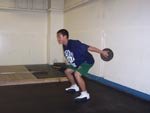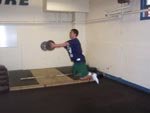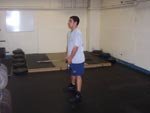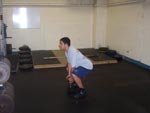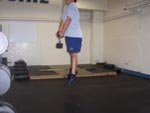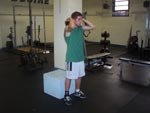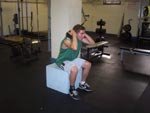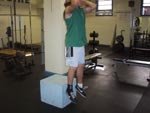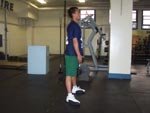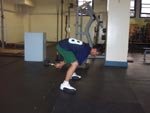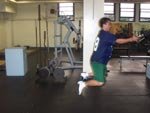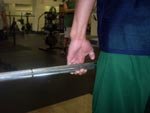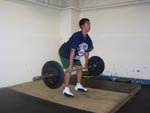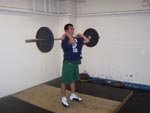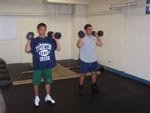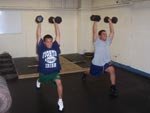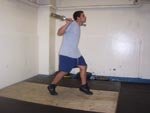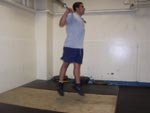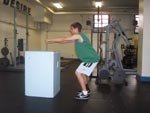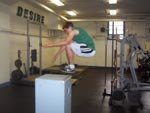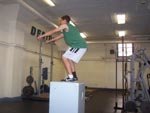1. Plate Jump
 </TD></TR><TR bgColor=#666666><TD width=10>
</TD></TR><TR bgColor=#666666><TD width=10>
 </TD><TD width=381>What's A Plateau?
</TD><TD width=381>What's A Plateau?
A level of attainment or achievement in weight loss or bodybuilding where one gets "stuck in a rut", barring further progress or noticable results. As obvious as it may seem, if you continue to do the same thing, you will continue to get the same results. Click here for tips on breaking through plateaus. </TD><TD width=10>
 </TD></TR><TR bgColor=#666666><TD colSpan=3>
</TD></TR><TR bgColor=#666666><TD colSpan=3>
 </TD></TR></TBODY></TABLE>
</TD></TR></TBODY></TABLE>
- This exercise will allow you to jump harder than you may want. By forcefully swinging the weights forward, the weights end up pulling the body upward and forward. The body must match the speed of the weights otherwise you would fall over forward.
This exercise teaches you to jump harder and faster on each attempt. Make sure to reset before each jump. This exercise can be performed for height, distance, laterally, off a single leg, or with different amounts of weight.
- Starting Position: Stand upright with a 10-pound plate in each hand. Execution: Swing the plates backward as you let your body bend downward in a countermovement.
Next, swing the plates forcefully forward and upward as you begin the jump. It's important to swing the plates all the way up to head level or higher. You can think of throwing the plates in front of you and letting the weight carry you. This exercise can be performed for 3 or 4 sets of 8-12 jumps.
- This exercise works on switching from a slow eccentric contraction, to a fast and force full concentric contraction. The body will be forced to create a large amount of force in a short amount of time. A good variation for this exercise is to have the athlete close their eyes. This makes it harder to time when the dumbbell will touch the ground.
Starting position: Stand upright while holding one end of a dumbbell with both hands. The dumbbell will hand with the free end facing downward.
- Execution: On the descent let your arms relax and hang down. Squat back slowly, don't allow your knees to travel forward, keep your lower back flat.
The dumbbell will eventually touch the ground in between your feet, not in front of them. The touching of the dumbbell to the ground should be thought of as a trigger, once you feel this, jump straight up as fast and as hard as possible. Do not bend your arms during the jump. This exercise can be performed for 3-4 sets of 8-15 reps.
- This exercise is similar to how Louis Simmons has defined a box squat. The muscles are in a relaxed pre-working state at the beginning of the exercise. The body must overcome the weight and inertia of both the body and external weight. The box supports the weight of the body and dumbbell at the beginning of contraction, not the muscles.
A large amount of force is created from this relaxed position in a short amount of time. This exercise relies more on starting strength than the traditional box squat since the athlete actually jumps.
Starting position: Place a dumbbell across your shoulders. The elbows will be facing straight ahead with the fingers on top of the dumbbell.
- Execution: With the back of your heels placed against the box, sit way back onto the box. Do not round your low back on the box, keep a flat and tight lower back position. As you sit on the box relax your hip flexors, but keep everything else tight. From this position jump as hard and as fast as possible straight up.
Reset after each jump. Do not use a barbell for this exercise, with a barbell the elbows and arms are turned out and opened up. This is a quick jump and you want to keep the body tight throughout the jump. A barbell will put the body is a vulnerable position, we are not working with heavy weights and there is no reason to add a balance element to this exercise. This exercise can be performed for 3-4 sets of 8-12 reps.
- This exercise is a combination of the DB Swing and the Pull Through. You get a big stretch of the posterior chain before a powerful hip extension. It's important to reach as far back as possible on the descent and to initiate the jump with the hips, not the arms.
Starting position: Take a wider than shoulder width stance and hold a dumbbell in the same way as in the frog squat.
- Execution: Swing the dumbbell down and backward between your legs, drop your head and reach as far back as possible. The jump is initiated by throwing the hips forward and up, let the weight lag behind. The extension of the hips will speed up the swing of the dumbbell.
As the dumbbell speeds up it will pull on the body similar to the plate jump. The last part of the jump will be sped up by the dumbbell pulling on the body. A large amount of force will be created during the late phase of the jump. This exercise can be performed for 3 sets of 6-10 reps.
- Execution: This exercise is the same as the traditional triple jump except you do not have an approach. With a shoulder-width stance, start with a horizontal jump. Land on one leg, then jump forcefully forward. Next, land on the other leg and jump forcefully forward again, then land softly with both legs. Reset after each attempt.
This exercise can be used as a training exercise or as a test. It's a great measure of single leg power, much better than the single leg vertical jump or horizontal jump. This is a great exercise to prepare the body for bounds or depth jumps. This exercise can be performed for 2-3 sets of 4-8 reps.
- Starting position: This exercise is just like the hang clean except it's performed with a finger grip. Hold the barbell with only your fingers, release your thumbs and open your hands. Stand up right with the barbell.
Execution: On the descent keep your knees in the same place. Do not allow the knees to travel forward, let the bar go straight down as the legs are pushed backward out of the way of the bar path. Let the bar travel down to the level of the knees, keeping the lower back flat. Now, forcefully extend the hips, knees and ankles, but do not allow the arms to lift or bend.
After full extension bend down, throw your elbows forward and up, catch the bar on your shoulders. The hands never close during this exercise, they start with the fingers holding the bar and end with the fingers under the bar.
- This exercise does two things for the athlete. It teaches you to not use your arms to pull the bar up, thus the hips become responsible for getting the bar up. Once you begin lifting the bar with your arms, the brain sends more impulses to the arms and less to the hip muscles. So you end up lifting with the smaller and weaker bicep muscles instead of the bigger, more powerful hip muscles.
When learning the Olympic lifts you will be able to lift more weight with your arms than with your legs. So many people never learn to do these lifts with their legs and thus will plateau early. Once the body adapts neurally, the inter-muscular and intra muscular coordination will improve in the lower body and you will be able to lift heavier and heavier weight. This will not happen if you continue to lift with your arms and take the hips out of the movement.


A level of attainment or achievement in weight loss or bodybuilding where one gets "stuck in a rut", barring further progress or noticable results. As obvious as it may seem, if you continue to do the same thing, you will continue to get the same results. Click here for tips on breaking through plateaus. </TD><TD width=10>


- Second, this is a great exercise for grip strength. For some reason grip training has been neglected recently. A strong grip is invaluable in many sports, especially explosive sports. Even more importantly a strong grip protects the elbow in overhead throwing movements. This exercise can be performed for 3-4 sets of 3-6 reps.
- Starting position: Take a shoulder width stance and point the toes straight ahead. Hold each DB up to your shoulders with your elbows pointing straight ahead. Allow one end of the DB to rest on each shoulder.
Execution: Drop straight down a few inches and forcefully jump and extend up. Then, as quick as you can, drop straight down into a lunge position. One leg should go forward and the other goes straight back. Catch the weight with your arms fully extended in the bottom position. Stand up with the arms extended until you are upright, take small steps up. The arms should be fully extended and behind the ears in the catch position.
- This exercise is all about getting down quick. Anytime you see "jerk," it means get down quick, not push up. The momentum of the jump should get the weight going up; the rest of the exercise is about getting underneath the weight before you catch it. This exercise can be performed for 2-4 sets of 8-10 reps.
- Execution: Take a barbell across your shoulders with one foot forward and the other foot backward. Allow your knees to bend slightly and quickly switch foot positions with a little jump. Switch foot positions back and forth quickly and forcefully.
- This is a calf exercise and gets a good stretch in the muscles. Slowly add weight to the barbell. This exercise can be performed for 3 sets of 15-25 reps.
- Starting position: Get in a half squat position with your arms in front of you. Execution-from this static position, jump up and onto the box. You want to jump from a still position, do not allow any counter movements. Land in the middle of the box and stand all the way up. Reset after each jump.
- This exercise teachers you to create a large amount of force from a static isometric position. The body starts in an isometric state where you are supporting the weight of the body, then you forcefully overcome the inertial and weight of the body. This exercise can be performed for 2-4 sets of 6-10 reps.
- Execution: This exercise is actually two jumps. Start away from the box and perform a horizontal jump to the box. Upon landing, as fast and as hard as possible jump up onto the box. This second jump needs to be as fast as possible, you can think of the ground being on fire and you need to get up quick. Land softly in the middle of the box and stand upright. Reset after each jump.
This exercise is a stretch-reflex exercise, but it's not as intense as a depth jump. It's a great exercise to prepare for more intense jumps. This exercise can be performed for 2-3 sets of 4-8 reps.




